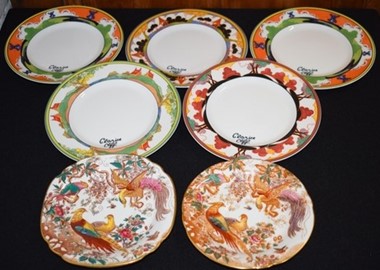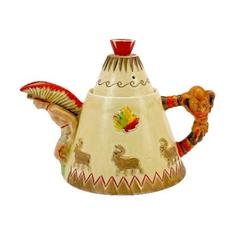Clarice Cliff
Clarice Cliff was a renowned English ceramic artist and designer, best known for her vibrant and innovative pottery produced in the 1920s and 1930s. Clarice was born on the 20th January 1899, in Tunstall, Stoke-on-Trent, Staffordshire, England.

Clarice Cliff began her career in 1912 at the age of 13, as an apprentice decorator, at Lingard Webster & Co., a pottery in Tunstall. In 1915 she transferred to Hollinshead & Kirkham as an apprentice in lithography. She attended evening classes at the Burslem School of Art and studied sculpture at the Royal College of Art. A year later in 1916, at 17 years old Clarice Cliff relocated to the factory of A.J. Wilkinson’s Royal Staffordshire Pottery. This was her final move as she was able to develop her skills and increase her career opportunities. Most of the young women in the Staffordshire Potteries would continue working in a particular range in order to raise their income above the rate of 'apprentice wages'. Clarice Cliff chose not to follow this traditional path, instead she acquired many skills such as modelling figurines and vases, gilding and hand-painting ware. Hand-painting included outlining, enamelling and banding (drawing radial bands on plates or vessels).
As the First World War drew to a close, business was booming for A.J. Wilkinson in both the domestic and overseas markets. With the return of Guy Shorter from the War, in 1920 Arthur Shorter retired and handed responsibility for the business to his sons. That same year they purchased the Newport Pottery in Burslem, which was incorporated into the Royal Staffordshire Pottery.

In the early 1920s, decorating manager Jack Walker brought Clarice Cliff’s artistic talents to the attention of one of the factory owners, Arthur Colley Austin Shorter. Shorter nurtured her skills in ceramics and gave her space to explore her own ideas. In 1922 Clarice was offered an apprenticeship as a modeller, where she worked alongside Wilkinson’s art director, John Butler and the designer Fred Ridgway, both were most impressed by Clarice Cliff’s abilities.

Clarice Cliff Ravel Design
Clarice Cliff travelled to Paris and she returned full of new ideas and the first sample batches were given the name ‘Bizarre’. As sales of Bizarre ware increased further decorators, or ‘paintresses’, were moved from Wilkinson’s and assigned to Clarice Cliff. By the close of 1927, Clarice had a team of 10 paintresses. They were known as the ‘Bizarre Girls’. The product was in endless demand. The factory produced items that the consumer could use in any room in the home.

In 1928 Clarice Cliff’s name started to be inscribed on the wares and ‘Bizarre by Clarice Cliff’ became the backstamp.

Clarice Cliff’s Bizarre Ware designs featured a wide range of shapes and forms, including vases, plates, teapots and more. Her designs often depicted landscapes, trees, flowers and other natural elements in bold and contrasting colours. The pottery pieces were hand-painted and each one was unique, adding to their artistic appeal.

Clarice Cliff Bizarre Coffee Set
In addition to the basic Bizarre range of patterns, further range names began to appear. The Fantasque line and Applique pattern range featured more expensive colours and the Latona and Inspiration pattern ranges used new glazes.
Fantasque Candle Holder
John Butler left the company in 1930 and Clarice Cliff replaced him as Art Director of both the Wilkinson and Newport potteries. Clarice Cliff realised the value of her signature and took the initiative to register her signature as a trademark. Towards the mid-1930s Clarice Cliff adapted her designs and shapes to suit changed consumer taste. Floral designs became more prominent and bright colours were replaced with pastels. Geometric shapes gave way to moulded and embossed wares. In 1936, possibly reflecting the change in decorating style, ‘Bizarre’ was removed from the company’s backstamp, leaving just the Clarice Cliff signature.
New modellers were employed, the first was Betty Silvester, who is credited with designing the Teepee teapot and the Student and Showgirl bookends. Peggy Davies joined the company in 1936 and she was responsible for designing most of the face masks produced by the factory. Aubrey Dunn was recruited in 1937 and the Fruit & Basket design was introduced in a variety of moulded shapes.
These three ranges represent the last significant moulded wares introduced at the factory.
With the outbreak of the Second World War in 1939, the men from the factory were drafted into the Armed Forces. The sense that this marked the end of an era was compounded by the death of Colley Shorter’s wife, Annie in the same year. With the reduction in work-force and adjustment to wartime austerity, production slowed. It seemed the days of greatest innovation, design and success were over. Arthur Colley Austin Shorter married Clarice Cliff in December 1940 and Clarice moved into his home at Chetwynd House on Northwood Lane in Clayton, Staffordshire. Clarice spent an increasing amount of time at her new home and developed a love of gardening.

During the war A.J. Wilkinson produced mostly white domestic tableware, hotel wares and wares for the troops. Hand painting continued in a limited way for export. At the end of the war with the return of the work force and despite ongoing wartime restrictions, Colley and Guy Shorter set about modernisation and improvements at the factory. The old bottle ovens were replaced with gas-fired continuous ovens and mechanisation was introduced. Clarice Cliff shifted her focus from design to management. She was appointed to the board of A.J. Wilkinson as a director. Even though Clarice Cliff continued to work in the ceramics industry she never achieved the same level of success as in her early years. Colley and Clarice spent less time at the factory and more time travelling and promoting the wares of A.J. Wilkinson.
Colley Shorter fell ill and died in 1963. Clarice Cliff retired and the factory sites were sold to W.R. Midwinter at the Albion and Hadderidge Potteries in Burslem, after ensuring that her staff would be employed. Clarice continued to live close to her former factory and witnessed the merger with Myott-Meakin and a director from Wedgwood appointed to the board.

A. J. Wilkinson's Royal Staffordshire Pottery on the bank of the Trent & Mersey Canal
Photo: © claricecliff.co.uk
On the 23rd October 1972, Clarice Cliff-Shorter died at Chetwynd House. She was found by her gardener sitting in her favourite chair listening to the radio. She was 73 years old.
Clarice Cliff gained international recognition and became highly sought after by collectors. Her designs were celebrated for their modernity and innovative approach to ceramics. Today Clarice Cliff’s pottery is considered iconic of the Art Deco movement and a significant contribution to 20th century design.

We are always proud to assist in the sale of within in our auctions, and would love to help in the preparation of even more! If you have an single item or a full collection, and would like to obtain a complimentary valuation, then please do contact us! Leighton Hall Auctions are very proud to offer free valuations of your items that you may consider without obligation to enter into one of our auctions. We can either offer valuations in person if you bring it into our saleroom or we can offer virtual valuations where one of our valuers will happily assist you in relation to valuing your valuables.
You can learn how to obtain a valuation by Clicking Here.





